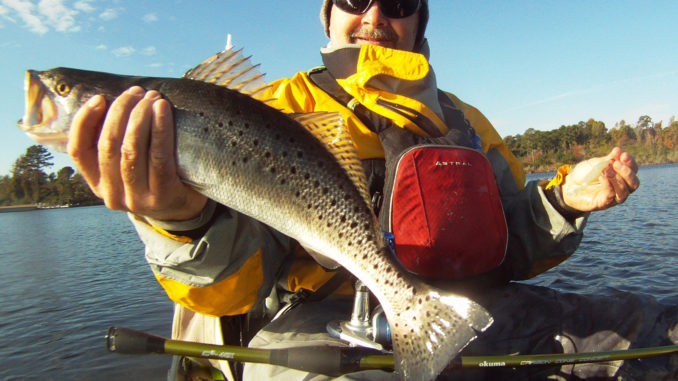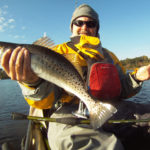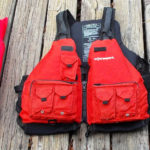
Pretrip precautions for paddlers
I had something else planned for this month but felt I needed to delay it and talk a little about boating safety because, so far, 2013 has been a tough one for North Carolina fishermen. In addition to the ever-present bad news seen nightly on the television news, a couple of young fishermen who had most of their lives still in front of them have been lost to canoe/kayak accidents.
First, Ricky Balance, who ran Smokers Only Lure Company, headed out to a duck blind in Coinjock Bay in a canoe on Dec. 23, and never returned. His body was not found until Jan. 13.
Next, Graham Hoard went kayak fishing in Queens Creek on a beautiful Jan. 12, and he never returned. His body was found much more quickly than Ballance’s.
I don’t know many details of either incident, but I send comforting thoughts and my prayers to their families and friends. I don’t know that either of these incidents could have been prevented, but I hope they won’t mind me pulling out my soapbox and stepping up to preach a little about safety.
Even in his grief, Hoard’s father, Tom, has been on several Internet chatboards urging kayakers to wear their PFDs. With the utmost of respect, this column is in the memory of Graham Hoard and Ricky Ballance, with hopes it will help save someone else.
Practicing boating and kayaking safety is a must. Unfortunately, it can become a matter of life and death. The following are a few basics of safety that I hope you will never need.
Personal floatation devices (PFDs) are required by law for anyone on any boat of any kind. In larger boats, when there are at least two people on board, I’ll consider having them readily available as being adequately prepared. However, if you are in a kayak or canoe, or fishing alone in a boat, your PFD needs to be worn at all times.
One of the excuses often given for not wearing a PFD is that they aren’t comfortable. I have tried a bunch, and will agree that some can be a little bothersome to wear all day. However, the flip side is that they can’t help unless they are being worn. I like the idea of inflatable PFDs, and they are out of the way better than anything else I’ve tried. It took seriously shopping for them to find one that was comfortable enough I didn’t mind wearing it, and now I’m glad I put in that time.
If you are shopping for a PFD at a kayak shop, ask to sit in a kayak of the same model as yours, or one with a similar seat, to see how it feels. Some PFDs fit well standing up but bind when sitting. If trying on PFDs in a tackle shop, pick up a rod and reel, and be sure it is comfortable when casting and retrieving.
In addition to a PFD, state boating laws require a sounding device (whistle or horn) for any vessel and flares for most vessels. Lighting regulations vary with the type of propulsion and size. Other regulations cover fire extinguishers and more. They can be found in the boating regulations section of the N.C. Wildlife Resources Commission’s Web site at www.ncwildlife.org.
Never make the assumption that you will not be out in low visibility or when it is dark and you won’t need lights. Sometimes this is beyond your control, so have proper lights — that work.
Now that you have a comfortable PFD you will actually wear, plus the proper safety equipment, the next thing about going fishing in your boat or kayak is to leave a float plan with a responsible person. This person has to be dependable and someone who will actually call to begin a search should you not return on time. A night in the marsh during the summer may only be uncomfortable and inconvenient, but during the winter it could be a life-threatening experience.
Your float plan should begin with your departure marina or launch site and what time you plan to return. It should include the make and color of your vehicle and your boat (or kayak), with any outstanding identification marks.
Next, draw up a rough fishing plan for someone on dry land, listing all places you might go on the trip. If you decide to deviate from the float plan in any way, you should get your cell phone out of its dry bag and text your responsible person and list your changes.
I am not a texter, but I believe texting is better for this than a phone call. With a text message, they have a written record of your changes without having to remember them. Text will also often transmit when the signal is too weak for a phone call. A simple reply of “OK” or “Got it” lets you know your update was received.
When you return, notify your contact. Mine is my wife, and I text her as soon as I step on ground at my launch site. My text is a simple message that says “I R back.” By the time I have the boat strapped down and ready to head home or my kayak loaded, I receive an equally simple reply of “Good” or “OK” or something similar. We’ll discuss the details of the trip later.
I have grown fond of some of the special, technical clothing made for fishermen and kayakers. During the summer, this is primarily bug- and sun-resistant clothing, but as the weather cools, there are options to stay warm, dry and comfortable. Some of this clothing is expensive, but if it keeps you comfortable and helps with your safety, it is well worth it.
It may be cliché, but no one wants to be a statistic, and safe boating is no accident. It only takes a little time to make this trip on the water a safe one and that helps ensure the opportunity to make the next trip.






Be the first to comment